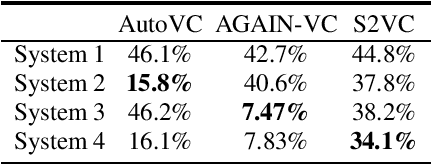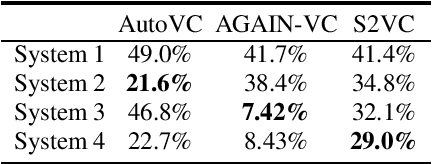Zexin Cai
Content Anonymization for Privacy in Long-form Audio
Oct 14, 2025Abstract:Voice anonymization techniques have been found to successfully obscure a speaker's acoustic identity in short, isolated utterances in benchmarks such as the VoicePrivacy Challenge. In practice, however, utterances seldom occur in isolation: long-form audio is commonplace in domains such as interviews, phone calls, and meetings. In these cases, many utterances from the same speaker are available, which pose a significantly greater privacy risk: given multiple utterances from the same speaker, an attacker could exploit an individual's vocabulary, syntax, and turns of phrase to re-identify them, even when their voice is completely disguised. To address this risk, we propose new content anonymization approaches. Our approach performs a contextual rewriting of the transcripts in an ASR-TTS pipeline to eliminate speaker-specific style while preserving meaning. We present results in a long-form telephone conversation setting demonstrating the effectiveness of a content-based attack on voice-anonymized speech. Then we show how the proposed content-based anonymization methods can mitigate this risk while preserving speech utility. Overall, we find that paraphrasing is an effective defense against content-based attacks and recommend that stakeholders adopt this step to ensure anonymity in long-form audio.
Scalable Controllable Accented TTS
Aug 10, 2025Abstract:We tackle the challenge of scaling accented TTS systems, expanding their capabilities to include much larger amounts of training data and a wider variety of accent labels, even for accents that are poorly represented or unlabeled in traditional TTS datasets. To achieve this, we employ two strategies: 1. Accent label discovery via a speech geolocation model, which automatically infers accent labels from raw speech data without relying solely on human annotation; 2. Timbre augmentation through kNN voice conversion to increase data diversity and model robustness. These strategies are validated on CommonVoice, where we fine-tune XTTS-v2 for accented TTS with accent labels discovered or enhanced using geolocation. We demonstrate that the resulting accented TTS model not only outperforms XTTS-v2 fine-tuned on self-reported accent labels in CommonVoice, but also existing accented TTS benchmarks.
Less is More for Synthetic Speech Detection in the Wild
Feb 08, 2025



Abstract:Driven by advances in self-supervised learning for speech, state-of-the-art synthetic speech detectors have achieved low error rates on popular benchmarks such as ASVspoof. However, prior benchmarks do not address the wide range of real-world variability in speech. Are reported error rates realistic in real-world conditions? To assess detector failure modes and robustness under controlled distribution shifts, we introduce ShiftySpeech, a benchmark with more than 3000 hours of synthetic speech from 7 domains, 6 TTS systems, 12 vocoders, and 3 languages. We found that all distribution shifts degraded model performance, and contrary to prior findings, training on more vocoders, speakers, or with data augmentation did not guarantee better generalization. In fact, we found that training on less diverse data resulted in better generalization, and that a detector fit using samples from a single carefully selected vocoder and a single speaker achieved state-of-the-art results on the challenging In-the-Wild benchmark.
GenVC: Self-Supervised Zero-Shot Voice Conversion
Feb 06, 2025Abstract:Zero-shot voice conversion has recently made substantial progress, but many models still depend on external supervised systems to disentangle speaker identity and linguistic content. Furthermore, current methods often use parallel conversion, where the converted speech inherits the source utterance's temporal structure, restricting speaker similarity and privacy. To overcome these limitations, we introduce GenVC, a generative zero-shot voice conversion model. GenVC learns to disentangle linguistic content and speaker style in a self-supervised manner, eliminating the need for external models and enabling efficient training on large, unlabeled datasets. Experimental results show that GenVC achieves state-of-the-art speaker similarity while maintaining naturalness competitive with leading approaches. Its autoregressive generation also allows the converted speech to deviate from the source utterance's temporal structure. This feature makes GenVC highly effective for voice anonymization, as it minimizes the preservation of source prosody and speaker characteristics, enhancing privacy protection.
HLTCOE JHU Submission to the Voice Privacy Challenge 2024
Sep 17, 2024



Abstract:We present a number of systems for the Voice Privacy Challenge, including voice conversion based systems such as the kNN-VC method and the WavLM voice Conversion method, and text-to-speech (TTS) based systems including Whisper-VITS. We found that while voice conversion systems better preserve emotional content, they struggle to conceal speaker identity in semi-white-box attack scenarios; conversely, TTS methods perform better at anonymization and worse at emotion preservation. Finally, we propose a random admixture system which seeks to balance out the strengths and weaknesses of the two category of systems, achieving a strong EER of over 40% while maintaining UAR at a respectable 47%.
Privacy versus Emotion Preservation Trade-offs in Emotion-Preserving Speaker Anonymization
Sep 05, 2024Abstract:Advances in speech technology now allow unprecedented access to personally identifiable information through speech. To protect such information, the differential privacy field has explored ways to anonymize speech while preserving its utility, including linguistic and paralinguistic aspects. However, anonymizing speech while maintaining emotional state remains challenging. We explore this problem in the context of the VoicePrivacy 2024 challenge. Specifically, we developed various speaker anonymization pipelines and find that approaches either excel at anonymization or preserving emotion state, but not both simultaneously. Achieving both would require an in-domain emotion recognizer. Additionally, we found that it is feasible to train a semi-effective speaker verification system using only emotion representations, demonstrating the challenge of separating these two modalities.
Self-supervised Reflective Learning through Self-distillation and Online Clustering for Speaker Representation Learning
Jan 03, 2024Abstract:Speaker representation learning is critical for modern voice recognition systems. While supervised learning techniques require extensive labeled data, unsupervised methodologies can leverage vast unlabeled corpora, offering a scalable solution. This paper introduces self-supervised reflective learning (SSRL), a novel paradigm that streamlines existing iterative unsupervised frameworks. SSRL integrates self-supervised knowledge distillation with online clustering to refine pseudo labels and train the model without iterative bottlenecks. Specifically, a teacher model continually refines pseudo labels through online clustering, providing dynamic supervision signals to train the student model. The student model undergoes noisy student training with input and model noise to boost its modeling capacity. The teacher model is updated via an exponential moving average of the student, acting as an ensemble of past iterations. Further, a pseudo label queue retains historical labels for consistency, and noisy label modeling directs learning towards clean samples. Experiments on VoxCeleb show SSRL's superiority over current iterative approaches, surpassing the performance of a 5-round method in just a single training round. Ablation studies validate the contributions of key components like noisy label modeling and pseudo label queues. Moreover, consistent improvements in pseudo labeling and the convergence of cluster counts demonstrate SSRL's effectiveness in deciphering unlabeled data. This work marks an important advancement in efficient and accurate speaker representation learning through the novel reflective learning paradigm.
The DKU-DUKEECE System for the Manipulation Region Location Task of ADD 2023
Aug 20, 2023



Abstract:This paper introduces our system designed for Track 2, which focuses on locating manipulated regions, in the second Audio Deepfake Detection Challenge (ADD 2023). Our approach involves the utilization of multiple detection systems to identify splicing regions and determine their authenticity. Specifically, we train and integrate two frame-level systems: one for boundary detection and the other for deepfake detection. Additionally, we employ a third VAE model trained exclusively on genuine data to determine the authenticity of a given audio clip. Through the fusion of these three systems, our top-performing solution for the ADD challenge achieves an impressive 82.23% sentence accuracy and an F1 score of 60.66%. This results in a final ADD score of 0.6713, securing the first rank in Track 2 of ADD 2023.
Waveform Boundary Detection for Partially Spoofed Audio
Nov 01, 2022



Abstract:The present paper proposes a waveform boundary detection system for audio spoofing attacks containing partially manipulated segments. Partially spoofed/fake audio, where part of the utterance is replaced, either with synthetic or natural audio clips, has recently been reported as one scenario of audio deepfakes. As deepfakes can be a threat to social security, the detection of such spoofing audio is essential. Accordingly, we propose to address the problem with a deep learning-based frame-level detection system that can detect partially spoofed audio and locate the manipulated pieces. Our proposed method is trained and evaluated on data provided by the ADD2022 Challenge. We evaluate our detection model concerning various acoustic features and network configurations. As a result, our detection system achieves an equal error rate (EER) of 6.58% on the ADD2022 challenge test set, which is the best performance in partially spoofed audio detection systems that can locate manipulated clips.
Identifying Source Speakers for Voice Conversion based Spoofing Attacks on Speaker Verification Systems
Jun 18, 2022



Abstract:An automatic speaker verification system aims to verify the speaker identity of a speech signal. However, a voice conversion system manipulates the original person's speech signal to make it sound like the target speaker's voice and deceive the speaker verification system. Most countermeasures for voice conversion-based spoofing attacks are designed to discriminate bona fide speech from spoofed speech for speaker verification systems. In this paper, we investigate the problem of source speaker identification -- inferring the identity of the source speaker given the voice converted speech. To perform source speaker identification, we simply add voice-converted speech data with the label of source speaker identity to the genuine speech dataset during speaker embedding network training. Experimental results show the feasibility of source speaker identification when training and testing with converted speeches from the same voice conversion model(s). When testing on converted speeches from an unseen voice conversion algorithm, the performance of source speaker identification improves when more voice conversion models are used during training.
 Add to Chrome
Add to Chrome Add to Firefox
Add to Firefox Add to Edge
Add to Edge